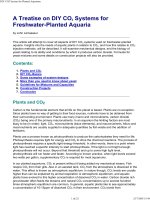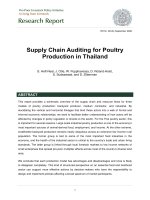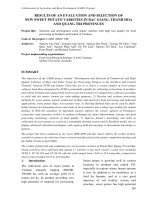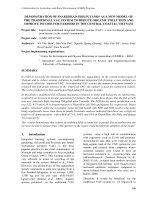Metabolix DP9002 for denitrification aquarium in applications
Bạn đang xem bản rút gọn của tài liệu. Xem và tải ngay bản đầy đủ của tài liệu tại đây (932.89 KB, 10 trang )
Metabolix DP9002 for
Denitrification Aquarium in
Applications
Overview
What are Polyhydroxyalkanoates (PHAs)
Three Nitrogen Conversion Pathways
Conventional versus New Denitrification
Oceanic Corals Canada Study
References – Denitrification
2
© 2013 Metabolix
Polyhydroxyalkanoates (PHAs)
Polyhydroxyalkanoates (PHAs) are linear polyesters
produced by bacterial fermentation of sugar or lipids
PHAs produced by bacteria to store carbon and energy
Polyhydroxybutyrates (PHBs) are
polyhydroxyalkanoates (PHAs)
The simplest and most commonly occurring form of
PHA is poly-ß-hydroxybutyrate (P3HB)
a PHB (produced by fermentative
production)
P3HB consists of 1,000 to 30,000
hydroxy fatty acid monomers
3
© 2013 Metabolix
Structure of poly-(R)-3-hydroxybutyrate
(P3HB), a polyhydroxyalkanoate
Three Nitrogen Conversion Pathways
Three nitrogen conversion pathways traditionally used
for the removal of ammonia–nitrogen in water
treatment, aquaculture and aquarium systems
– 1) Photoautotrophic removal by algae
– 2) Autotrophic bacterial conversion of ammonia–nitrogen to
nitrate–nitrogen
– 3) Heterotrophic bacterial conversion of ammonia–nitrogen
directly to microbial biomass
PHA/PHB is used as a carbon source for
– 2) Autotrophic bacterial conversion pathway
– 3) Heterotrophic bacterial conversion pathway
4
© 2013 Metabolix
Conventional versus New Denitrification
Source: Boley et.al., Biodegradable polymers as solid substrate and biofilm carrier for denitrification in recirculated aquaculture
systems, Aquacultural Engineering 22 (2000) 75-85
5
© 2013 Metabolix
DP9002 for Denitrification
Small, white to light brown colored pellets developed for
denitrification in aquariums
6
© 2013 Metabolix
Oceanic Corals Canada Study
Nitrate
40
35
0.12
30
0.1
25
0.08
20
0.06
15
0.04
10
5
0.02
0
0
1 2 3 4 5 6 7 8 9 10 11 12 13 14 15 16 17 18 19 20
days
7
Days
1
2
3
4
5
6
7
8
9
10
11
12
13
14
15
16
17
18
19
20
21
(mg/L)
Phosphate
0.14
Test Aquarium Specifications
Fluidized Reactor Specifications
•
175 gallons
•
Vertex UF-20 with 1460 grams of PHA Pellets
•
Computer controlled lighting cycles and mineral
additives
•
Water flow = 265 GPH
•
22 fish, various corals and inverts
•
Daily feeding regimen is identical controlled
amounts
•
Protein Skimmer runs 24/7
•
No water changes were during time of study
© 2013 Metabolix
Source: Oceanic Corals Canada, 2010
Data for PHA in Denitrification
PHA is comparable with other carbon-based systems
– Efficiency rate of approx. 2.4 – 7 g PHA / g of N2*
PHA is also active in phosphate removal
PHA is certified Marine Biodegradable per ASTM 7081
100% Bio-based
No fillers
* Source: Gutierrez-Wing et.al., Polyhydroxyalkanoates as a carbon source for denitrification of water, World Environmental and
Water Resources Congress 2007
8
© 2013 Metabolix
References – Denitrification
1. Boley A, Müller W-R (2001) Evaluation of different biodegradable polymers for nitrate removal in
aquaria. Bulletin de l’Institut océanographique, Special 20
2. Boley A, Müller W-R, Haider G (2000) Biodegradable polymers as solid substrate and biofilm
carrier for denitrification in recirculated aquaculture systems. Aquacultural Engineering 22: 75-85
3. Ebeling J M, Hightower P G (2010) Preliminary evaluation of three PHA formulations for passive
self-regulating denitrification technology. Aquaculture Systems Technologies
4. Ebeling J M, Timmons M B, Bisogni JJ (2006) Engineering analysis of the stoichiometry of
photoautotrophic, autotrophic, and heterotrophic removal of ammonia–nitrogen in aquaculture
systems. Aquaculture 257: 346-358
5. Gutierrez-Wing M T, Rusch K A, Malone R F (2007) Polyhydroxyalkanoates as a carbon source
for Denitrification of waters. World Environmental and Water Resources Congress 2007
6. Hiraishi A, Khan S T (2003) Application of polyhydroxyalkanoates for denitrification in water and
wastewater treatment. Appl Microbiol Biotechnol 61:103-109
7. Qin L, Liu Y, Tay J-H (2005) Denitrification on poly-b-hydroxybutyrate in microbial granular
sludge sequencing batch reactor. Water Research 39: 1503-1510
8. Van Rijn J, Tal Y, Schreier H J (2006) Denitrification in recirculating systems: Theory and
applications. Aquacultural Engineering 34: 364-376
9
© 2013 Metabolix
Disclaimer
NOTICE: Customer assumes all risk and liability for any use or handling of
this product beyond Metabolix’s direct control. Customer is responsible for
obtaining any licenses or other rights necessary to make, use or sell products
containing Mirel/M•vera compounds. Customer should consult its legal
counsel to determine whether its labels for products made with Mirel/M•vera
compounds are in compliance with applicable laws and regulations. Metabolix
shall not be responsible for any consequential, special or incidental damages,
and liability for breach of warranty, negligence or other claims is limited to the
purchase price of material purchased. The information contained herein is
believed to be reliable; however, Metabolix makes NO REPRESENTATIONS,
GUARANTEES OR WARRANTIES, EXPRESS OR IMPLIED, INCLUDING,
BUT NOT LIMITED TO, THE IMPLIED WARRANTIES OF
MERCHANTABILITY AND FITNESS FOR A PARTICULAR PURPOSE.
10
© 2013 Metabolix









